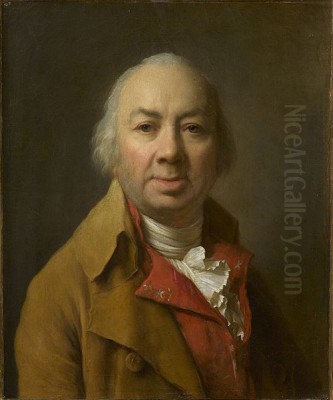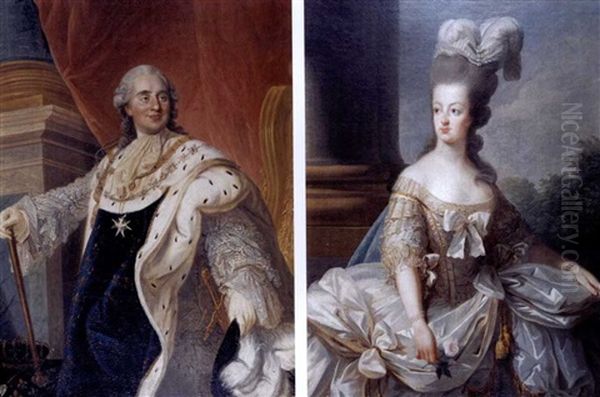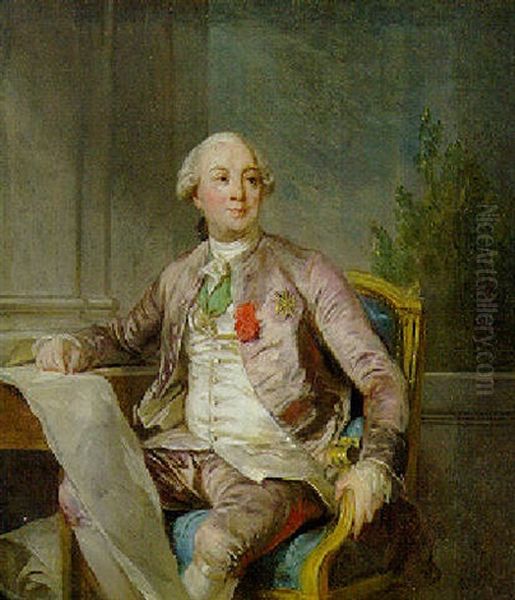
Joseph-Siffred Duplessis stands as a significant figure in the annals of French art, a painter whose career spanned the twilight of the Rococo period and the dawn of Neoclassicism. Born on September 22, 1725, in Carpentras, a town in the Comtat Venaissin near Avignon in southern France, Duplessis was destined for a life immersed in art. He passed away in Versailles on April 1, 1802, leaving behind a legacy of portraits renowned for their striking clarity, psychological depth, and masterful execution. His ability to capture not just a likeness but the very essence of his sitters made him one of the most sought-after portraitists of his era, immortalizing figures from French royalty to American statesmen.
Early Life and Artistic Formation in Carpentras
Duplessis's artistic journey began in a supportive and culturally rich environment. His father, Joseph-Guillaume Duplessis, was a surgeon by profession but also a passionate amateur artist, providing young Joseph-Siffred with his initial instruction in drawing and painting. This early exposure to art within his own family undoubtedly nurtured his burgeoning talent. His mother, Marie-Thérèse de Romanet, hailed from a prosperous local family, likely providing a degree of financial stability and social connection that could benefit an aspiring artist.
Carpentras itself, though provincial, was not an artistic backwater. It possessed a notable cultural heritage, and the artistic currents of nearby Avignon and the broader Provençal region would have been accessible. The young Duplessis absorbed these local influences, but his ambitions, and indeed his talent, soon required a broader stage. His father recognized his son's potential and understood that further training under established masters was essential for his development.
The Roman Sojourn: Apprenticeship and Influence
Around 1744 or 1745, Duplessis embarked on a pivotal journey to Rome, the veritable epicenter of artistic training and inspiration in Europe. This period was crucial for any aspiring artist wishing to study the masterpieces of antiquity and the Renaissance, as well as to learn from contemporary masters. In Rome, Duplessis entered the studio of Pierre Subleyras (1699–1749), a fellow Frenchman also from the south of France, who had established a successful career in the papal city.

Subleyras was a highly respected painter, known for his religious compositions, genre scenes, and particularly his insightful portraits, which were characterized by their naturalism and psychological acuity. Under Subleyras's tutelage, which lasted approximately four years, Duplessis honed his technical skills and absorbed his master's emphasis on direct observation and the truthful depiction of character. The influence of Subleyras's clear, unpretentious style can be discerned in Duplessis's later work, particularly in his ability to convey a sense of immediacy and presence in his sitters.
During his time in Rome, Duplessis also formed a significant friendship with another French artist, Claude-Joseph Vernet (1714–1789). Vernet, already gaining fame for his dramatic seascapes and landscapes, was a prominent figure in the French artistic community in Rome. This friendship would prove enduring and beneficial, connecting Duplessis to a wider network of artists and patrons. The Roman artistic milieu, bustling with artists like Pompeo Batoni, Anton Raphael Mengs, and numerous French Academy pensionnaires, provided a stimulating environment for the young painter.
Return to Paris and Rise to Prominence
Around 1752, Duplessis returned to France, choosing Paris as the city to establish his career. The French capital was the undisputed center of the European art world, and success there required immense talent and perseverance. He initially joined the Académie de Saint-Luc, a guild of painters and sculptors that offered an alternative, though less prestigious, route to recognition than the dominant Académie Royale de Peinture et de Sculpture.
Exhibiting his works at the Salon de l'Académie de Saint-Luc, Duplessis began to attract attention for the quality and insight of his portraits. His reputation grew steadily, and his ability to capture not only a physical likeness but also the personality and social standing of his sitters appealed to a discerning clientele. His portraits from this period demonstrate a developing mastery of technique, a refined sense of color, and a keen eye for detail, all hallmarks of his mature style. He was navigating an art world where portraitists like Jean-Marc Nattier had set a high bar for elegant, flattering depictions, and where the pastel portraits of Maurice Quentin de La Tour offered penetrating psychological insights.
The Royal Academician and Court Painter

Duplessis's talent did not go unnoticed by the artistic establishment. In 1764, he was approved (agréé) by the prestigious Académie Royale de Peinture et de Sculpture, a significant step in his career. His reception piece for full membership, presented in 1774, consisted of portraits of the sculptor Christophe Gabriel Allegrain and the painter Joseph-Marie Vien. This formal acceptance into the Académie Royale cemented his status as one of France's leading portraitists. He became a regular exhibitor at the official Paris Salon, the most important art exhibition in Europe, where his works were often met with critical acclaim.
His skill and reputation eventually brought him to the attention of the French court. He received commissions to paint some of the most powerful and influential figures of the Ancien Régime, including members of the royal family. In 1771, he was appointed peintre du Roi (Painter to the King). His portraits of King Louis XVI, particularly the official state portrait depicting the monarch in his coronation robes (1776), became iconic images of the French monarchy in its final years. These commissions underscored his preeminence in the field of portraiture, placing him alongside other favored court painters such as Antoine-François Callet and, for the queen, Élisabeth Vigée Le Brun.
Artistic Style and Technique: Clarity, Immediacy, and Psychological Depth
Duplessis's artistic style is characterized by its remarkable clarity, directness, and psychological penetration. While working within the broader stylistic currents of late Rococo and emerging Neoclassicism, he developed a distinctive approach to portraiture that focused on capturing the individual character of his sitters.
His paintings exhibit a meticulous attention to detail, particularly in the rendering of fabrics, accessories, and facial features. However, this detail never overwhelms the overall composition or detracts from the sitter's presence. Duplessis possessed a sophisticated understanding of light and shadow, using chiaroscuro to model forms and create a sense of volume and depth. His color palettes could range from the rich, vibrant hues favored in Rococo painting, as seen in some of his ceremonial portraits, to more subdued and naturalistic tones that lent an air of sobriety and realism, aligning with Neoclassical sensibilities.
What truly set Duplessis apart was his ability to convey a sense of "immediacy"—his subjects often appear as if they might speak or move at any moment. He eschewed excessive flattery or idealized representations, preferring instead to present his sitters with a sense of authenticity and naturalism. This is evident in the subtle nuances of expression he captured, revealing glimpses of their personality, intellect, or emotional state. His approach contrasted with the more overtly decorative or allegorical style of some of his Rococo predecessors like François Boucher or Jean-Honoré Fragonard, and aligned more with the directness found in the work of portraitists like Jean-Baptiste Perronneau, though Duplessis worked primarily in oils.
Key Masterpieces: Immortalizing Icons
Duplessis's oeuvre includes several masterpieces that have become iconic representations of their subjects and the era.
Portrait of Benjamin Franklin (c. 1778): Perhaps his most internationally renowned work, Duplessis painted several versions of the American statesman Benjamin Franklin during Franklin's time as ambassador to France. The most famous of these, often referred to as the "fur collar" portrait, depicts Franklin with a simple, unadorned coat and a fur collar, his expression one of quiet wisdom and benevolence. Duplessis masterfully captured Franklin's intellectual gravitas and unpretentious demeanor, creating an image that perfectly embodied the spirit of the American Enlightenment and its representative. This portrait was widely reproduced in engravings and became the definitive image of Franklin for many, influencing even the design of the U.S. one-hundred-dollar bill.
Portrait of Louis XVI (1776): As an official painter to the king, Duplessis was tasked with creating portraits of Louis XVI. His depiction of the monarch in full coronation regalia, surrounded by the symbols of French royal power, is a masterful example of state portraiture. Despite the formal requirements of such a commission, Duplessis managed to imbue the king's face with a degree of individual character, though the primary aim was to project majesty and authority. This work stands as a significant historical document, capturing the image of a king on the cusp of revolutionary upheaval.
Portrait of Christoph Willibald Gluck (1775): Duplessis's portrait of the renowned opera composer Christoph Willibald Gluck is considered one of the finest and most insightful depictions of the musician. Painted at the height of Gluck's fame and his efforts to reform opera, the portrait shows the composer seated at a clavichord, his gaze intense and thoughtful. Duplessis captured the creative energy and intellectual force of Gluck, making it more than just a likeness but a profound character study. This work is often lauded for its realism and the sense of direct engagement with the sitter.
Portrait of the Comte d'Angiviller (1786): Charles-Claude de Flahaut de la Billarderie, Comte d'Angiviller, was the Director-General of the Bâtiments du Roi, a powerful position overseeing royal artistic commissions and institutions. Duplessis's portrait depicts him with an air of dignified authority, surrounded by attributes of his office, including architectural plans and classical sculptures. The painting reflects the Comte's significant role as an arts administrator and patron during a period of stylistic transition, championing a return to classical grandeur that prefigured Neoclassicism.
Other notable sitters included Jacques Necker, the finance minister, and various members of the French aristocracy and bourgeoisie, each portrait demonstrating Duplessis's consistent ability to combine technical finesse with perceptive characterization.
Duplessis and His Contemporaries: A Vibrant Artistic Milieu
Joseph-Siffred Duplessis worked during a dynamic period in French art, surrounded by a constellation of talented contemporaries. The portraiture market in Paris was competitive, with artists like Alexander Roslin (a Swede highly successful in Paris), Louis-Michel van Loo, and the aforementioned Jean-Marc Nattier catering to aristocratic and royal patrons. The rise of exceptionally talented female portraitists, such as Élisabeth Vigée Le Brun and Adélaïde Labille-Guiard, further enriched the artistic landscape, each bringing their unique sensibilities to the genre.
While Duplessis shared the Rococo era's appreciation for elegance and refined technique, his emphasis on naturalism and psychological depth distinguished his work from the more overtly decorative or idealized portraits of some contemporaries. As Neoclassicism began to gain traction, championed by artists like Jacques-Louis David, Duplessis's style, with its inherent clarity and sobriety, found itself well-aligned with the changing tastes. His directness and avoidance of artifice resonated with the Neoclassical demand for truth and moral seriousness, even if his work never fully embraced the heroic or didactic themes of high Neoclassicism. He also navigated a world where genre painters like Jean-Baptiste Greuze explored sentimental and moralizing themes that captivated the public.
His friendship with Joseph Vernet, a master of landscape and marine painting, and his academic connections with figures like Joseph-Marie Vien, a key proponent of early Neoclassicism, placed him within a diverse network of artistic exchange and influence. The Salons provided a public forum where his works were seen alongside those of Hubert Robert, known for his picturesque ruins, and many others, fostering both rivalry and mutual inspiration.
Beyond the Brush: Scholarly Pursuits and Material Knowledge
Duplessis was not only a skilled practitioner but also an artist with a keen interest in the technical aspects of his craft. This intellectual curiosity is exemplified by his research into pigments. In 1786, he submitted a memorandum to the Académie Royale de Peinture et de Sculpture concerning the preparation and properties of red lake pigments (laques rouges). These pigments, derived from organic sources, were known for their vibrant color but also, unfortunately, for their tendency to fade.
In his research, Duplessis explored methods to improve the durability and brilliance of these crucial colors. He experimented with different sources, noting that animal-derived colorants (like cochineal) often yielded more stable pigments than those from plant sources. He even collaborated with the chemist Jean Darcet to test the effects of various materials and processes on pigment quality. This endeavor demonstrates a scientific approach to artistic materials, reflecting the Enlightenment's emphasis on empirical investigation and the pursuit of knowledge. It highlights Duplessis as an artist who was deeply invested in the permanence and quality of his work, respecting artistic tradition while also embracing scientific inquiry to enhance his medium.
Personal Life and Character: A Glimpse of the Man
While historical records primarily focus on an artist's public career and works, occasional anecdotes offer glimpses into their personal character. One such story reveals a tender side to Joseph-Siffred Duplessis. It is recorded that he held a deep affection for his pet dog. Upon the dog's death, Duplessis was moved to write a heartfelt letter expressing his grief and his fond remembrance of his loyal companion.
This anecdote, though small, humanizes the artist, showing him to be a man capable of profound emotional attachment. In an era where companionship with animals was common but not always documented with such personal expression, this detail suggests a sensitivity that perhaps also informed his insightful portrayals of human subjects. It hints at an empathetic nature, a quality invaluable for a portraitist whose task is to look beyond the surface and capture the inner life of an individual.
The Tumult of Revolution and Later Years
The French Revolution, beginning in 1789, brought profound changes to French society and inevitably impacted the lives and careers of artists, especially those associated with the Ancien Régime. As a painter who had served King Louis XVI and the aristocracy, Duplessis faced a precarious situation. Royal patronage ceased, and the demand for portraits of the nobility dwindled. Many artists struggled to adapt to the new political and social order.
Despite these challenges, Duplessis's reputation for skill and integrity appears to have helped him navigate this turbulent period. While his income and commissions undoubtedly suffered, he continued to work. A significant appointment came in his later years: in 1796, during the Directory, he was appointed as a curator and conservator at the newly established Musée Spécial de l'École française at the Palace of Versailles. This role involved the care and organization of the nationalized art collections housed in the former royal palace, a testament to his respected position within the artistic community even after the fall of the monarchy.
His work as a curator demonstrated his continued dedication to art, not just as a creator but also as a preserver of cultural heritage. He spent his final years in Versailles, surrounded by the masterpieces he was tasked to protect. Joseph-Siffred Duplessis died on April 1, 1802, at the age of 76.
Legacy and Enduring Influence
Joseph-Siffred Duplessis left an indelible mark on 18th-century French portraiture. His works are prized not only for their artistic merit but also as invaluable historical documents, offering vivid portrayals of some of the most significant figures of his time. His ability to combine technical mastery with profound psychological insight ensured that his portraits transcended mere likeness, becoming enduring character studies.
His paintings are held in major museum collections worldwide, including the Louvre in Paris, the Palace of Versailles, the Metropolitan Museum of Art in New York, and the National Portrait Gallery in Washington D.C. The continued reproduction of his Benjamin Franklin portrait, particularly on American currency, has given his work an unusually widespread and lasting public presence.
As an artist who successfully navigated the stylistic shifts from Rococo to Neoclassicism, Duplessis demonstrated both adaptability and a consistent personal vision. His commitment to clarity, directness, and the authentic representation of his sitters ensured his relevance throughout his long career and secured his place as one of the great portraitists of the French Enlightenment. His legacy is one of artistic excellence, insightful human observation, and a dedication to the craft of painting that continues to inspire admiration.